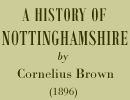< Previous | Contents | Next >
Thurgarton and Hoveringham
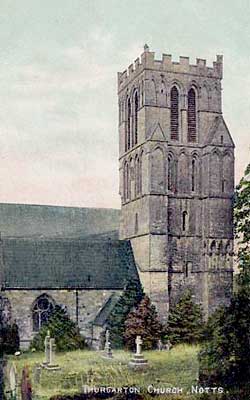
The Early English north tower of Thurgarton Priory church.
THURGARTON occupies a charming position at the foot of two hills, with a little stream running through the heart of it to join the broad waters of the Trent about a mile away. Of Thurgarton Priory and its canons, history has much that is interesting to say, for we must go back almost to the time of the Norman Conquest to trace the origin and foundation of this important house. Walter Deincourt was the son of one of the Conqueror’s companions who was granted no less than sixty-seven lordships as his share of the Saxon spoils. These included Thurgarton, Fiskerton, and others in this county; but the great feudal chieftain made his residence at Blankney in Lincolnshire. Ralph Deincourt, the son of Walter, succeeded to these vast possessions, and founded a religious house at Thurgarton in the reign of Henry I. One old authority says he ‘ turned his house into an abbey,’ and placed it under the direction of the canons of the Order of St. Augustine. Coming under the influence of Archbishop Thurstan, he was induced to endow the monastery with all Thurgarton and Fiskerton, the full text of the foundation deed being given by Dugdale. The canons lived together under one roof, and were habited in a long black cassock with a white rochet over it; and this was covered with a black cloak and hood. According to Bishop Tanner, the Austin canons were less strict than the monks, and wore beards and caps.
The work which Deincourt began was continued long after his death. Benefactors came forward to add further to the riches of the priory. It participated in the gifts of royalty and high ecclesiastics until it owned considerable property in all parts of the county, as well as in Derbyshire and Lincolnshire. The priory church received at the hands of the founders considerable attention; and its beautiful Early English work testifies to the skill of the ancient builders. Thoroton says that in 1328 the church was valued at twenty marks per annum; and he details several perquisites which belonged to it. The manorial rights included the contribution of a cock and hen by the cottagers beside their rents. These were paid about Christmas time, and on that day the tenants were either regaled in the hall of the priory, or given a white loaf, a flagon of ale, and a dish of food. The natives had also to contribute threepence each in reaping time, cleanse the mill-dam, plough and reap for their religious superiors; and each ‘she native’ had to pay five shillings and four-pence when she was married; while the fine upon the daughter of a cottager was half that sum. In 1328 the value of the manor was put at £85 9s.1d.
For long centuries these curious customs prevailed; and when the monasteries were dissolved by Henry VIII. the clear income of Thurgarton Priory had risen to £259 9s. 4d. Upon the surrender of the property by the canons, the King granted the manor partly to Trinity College, Cambridge, and partly to William Cooper, who was in the royal service. The priory thus became the abode of the Coopers, and Sir Roger Cooper was a stalwart partisan of King Charles in the Civil War. He fortified his house; and on one occasion, as the Parliamentary troops were passing to take up quarters round Newark, some of his musketeers fired, and a Captain Heywood was killed. Colonel Thornhaugh thereupon sent to Colonel Hutchinson for infantry to attack the place, and Sir Roger, with forty followers, was captured and sent to Nottingham. After the surrender of the house it was ransacked, and the troopers participated in the booty. The times went very ill with the Coopers; for in a memorial to the Protector presented by Jane, wife of John Cooper, second son of Sir Roger, we find her praying his Highness to allow her husband to return to his patrimony and enable him to extricate himself from the load of debt with which he was embarrassed.
At the Restoration a measure of prosperity returned to them, for Mr. John Cooper was appointed carver to the King, receiver-general of the royal aid and additional supply, and collector of the hearth-money in Nottinghamshire.
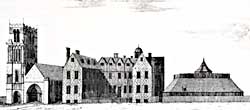
Thurgarton Priory in the early 18th century as drawn by Samuel Buck (1726).
The close of the seventeenth century saw the Thurgarton estate pass by devise to Mr. John Gilbert, who also took the name of Cooper. His son, John Gilbert Cooper, was an author of some ability; and in the church there is a tablet to the memory of himself and wife. At the end of the last century another Mr. Cooper demolished the old priory, so that nothing of it was left but the cellars. On its site was erected the present mansion, which, with the estate, was purchased of the Coopers by Mr. Milward. His nephew, Mr. Richard Milward, J.P., restored the Early English church in 1854; and, dying in 1879, a brass, on which is an appropriate inscription, was erected to his memory. There are several memorials to the Coopers over the north door, and three old oak stalls with curious carving upon them are worthy of inspection. The priory is occupied by the Bishop of Southwell, in whose diocese it stands; the owner of the property, who bought it recently, being Mr. Robinson, of Nottingham.
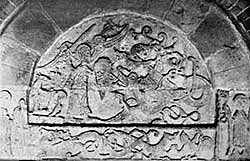
The tympanum at Hoveringham church.
A short walk from Thurgarton lies the charming little summer resort of Hoveringham, on the banks of the Trent. From the Domesday Survey we learn that besides mills and fisheries there was a priest and a church here; but the only relic of these early times is a Norman tympanum over the church door, on which is depicted the conflict between Michael the Archangel and the Dragon. The former owners of Hoveringham were the Goushills, or Gousills; and Simon de Goushill was summoned to the military muster at Nottingham in 1297. Walter, the next in succession, attended the Parliament at Northampton in 1307 as Knight of the Shire for Notts. He was also a justice of the gaol delivery in 1316, and was one of the lords of East Bridgeford, Hawksworth, Flintham, Kneeton, Fiskerton, Thurgarton, Hoveringham, Gonalston, and Rollestone.
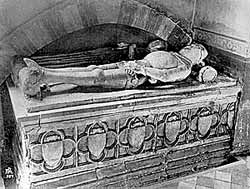
Tomb of Sir Robert de Goushill.
The Goushills continued in possession of the property till the time of Sir Robert, who married the Duchess of Norfolk. This noble lady seems to have passed through many vicissitudes. She was the daughter of the Earl of Arundel, and her first husband was William de Montacute, only son of the second Earl of Salisbury. He died young, and some years afterwards she married Thomas Mowbray, Earl of Nottingham, afterwards created Duke of Norfolk. His public career is well known in history, and it is affirmed of him that so callous was he to family ties, that he aided in the destruction of the Earl of Arundel, his father-in-law. The quarrel between him and the Duke of Hereford resulted in King Richard banishing Hereford for ten years, and Norfolk for life. On the latter’s death, in 1399, the Duchess married Sir Robert Goushill, and both of them died in 1404, for an inquiry bearing that date was made in order to discover the extent of the lands owned by them in various counties. At the west end of the church is the tomb of Sir Robert and his famous wife, bearing their effigies in alabaster.
They had two daughters, who married Sir Thomas Wingfield and Baron Stanley, Lord Chamberlain to the King. The romance attaching to the life of the Duchess of Norfolk invests with interest the memorial in the church, which stands near the entrance door, in an excellent state of preservation.
